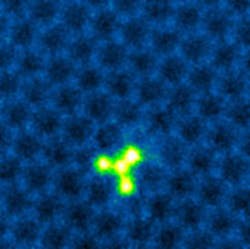3D Printing at the Nanoscale Level
A novel technique that nudges single atoms to switch places within an atomically thin material could bring scientists another step closer to realizing theoretical physicist Richard Feynman’s vision of nanotechnology, and building tiny machines from the atom up. This approach could be used to “build” materials that harness the quantum nature of atoms and the demand for such materials is driving the need to build atomically precise electronics and sensors. Fabricating nanoscale devices atom by atom requires delicacy and precision, which has been demonstrated by a microscopy team at the DoE’s Oak Ridge National Laboratory.
The researchers used a scanning transmission electron microscope, or STEM, at the lab’s Center for Nanophase Materials Sciences to inject silicon atoms into a single-atom-thick sheet of graphene. STEM has recently emerged as a tool for manipulating atoms in materials while preserving the sample’s stability. As the electron beam scans across the material, its energy slightly disrupts the graphene’s molecular structure and creates room for a nearby silicon atom to swap places with a carbon atom.
“We tracked an electron beam-assisted chemical reaction induced at a single-atom and chemical-bond level, and each step was captured by the microscope, which is rare,” says ORNL researcher Ondrej Dyck.
Using this process, the scientists brought two, three, and four silicon atoms together to build clusters and make them rotate within the graphene layer. Graphene is a two-dimensional, or 2D, layer of carbon atoms with unprecedented strength and high electrical conductivity. Dyck selected graphene for this work because it is robust and can withstand a 60-kV electron beam.
“We can look at graphene with the electron beam for long periods of time without damaging the sample, compared with other 2D materials such as transition metal dichalcogenide monolayers, which tend to fall apart more easily under the electron beam,” he adds.
With a STEM microscope, ORNL’s Ondrej Dyck brought two, three, and four silicon atoms together to build clusters and make them rotate within a layer of graphene, a two-dimensional layer of carbon atoms that exhibits unprecedented strength and high electrical conductivity. (Credit: Ondrej Dyck/Oak Ridge National Laboratory)
Dyck and his ORNL colleagues are among the few scientists learning to control the movement of single atoms in 2D materials using the STEM. Their work supports an ORNL-led initiative coined The Atomic Forge, which encourages the microscopy community to reimagine STEM as a method to build materials from scratch.
The fields of nanoscience and nanotechnology have experienced explosive growth in recent years. One of the earlier steps toward Feynman’s idea of building tiny machines atom by atom, a follow-on from his original theory of atomic manipulation first presented in his famous 1959 lecture, was seeded by the work of IBM fellow Donald Eigler. Eigler was the first to manipulate atoms using a scanning tunneling microscope; until the use of STEM at ORNL, his method was the only way to move atoms one by one.
Successfully moving atoms in the STEM could be a crucial step toward fabricating quantum devices one atom at a time. The scientists will next try introducing other atoms such as phosphorus into the graphene structure.
“Phosphorus has potential because it contains one extra electron compared to carbon,” Dyck says. “This would be ideal for building a quantum bit, or qubit—the basis for quantum-based devices.”
Dyck cautions that although building a qubit from phosphorus-doped graphene is on the horizon, how it would behave at ambient temperatures, and outside of the STEM or a cryogenic environment, is still a mystery. “We have found that exposing the silicon-doped graphene to the outside world does affects their structures,” he says.
The team will continue to experiment with ways to keep the material stable in non-laboratory environments, which is important to the future success of STEM-built atomically precise structures.


